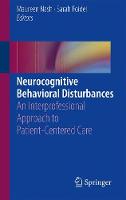(To see other currencies, click on price)
MORE ABOUT THIS BOOK
Main description:
Dementia, now known as major neurocognitive disorder, is not one monolithic disease. Nor is behavior disturbance driven by one particular neurocognitive dysfunction. In fact if we are able to understand it, behavior is an excellent form of nonverbal communication. There are many different causes of dementia. A major challenge with both researching and implementing interventions is viewing dementia and related behaviors as single entities. This approach leaves room for critical errors in the treatment of dementia patients, beginning with misdiagnosis.
This book approaches dementia by reviewing cognitive and functional assessments to provide a more accurate diagnosis, which then allows physicians to design specific interventions that are tailored to the person and their challenges. Because person centered care is vital to quality of life and longevity to an aging patient, this understanding of individual needs is vital.
Written by experts in the field, this book incorporates the latest evidence-based behavioral interventions matched to specific deficits. Behavioral management focuses not on controlling behavior, but using it to teach staff and caregivers how to interpret common actions and maximize function for people with major neurocognitive disorders. Quality of life and individualized care planning will be the theme and the book will provide practical case examples.
The book begins by introducing dementia and other neurocognitive illnesses, contextualizing them both historically and contemporarily. Next, the text focuses on the comprehensive assessment of a person with neurocognitive challenges in order to identify strengths and understand what the person is trying to communicate with their behavior. This process allows individualized care planning and behavioral (non-pharmacologic) management to meet the cognitive challenges and maximize individual strengths and thereby improve outcomes, making this a cutting edge resource.
Contents:
1. Introduction
a. Background of Dementia as a leading health concern
b. History of treatment and assessment
2. The roles of an interprofessional team for assessment
a. Defining roles and scope of practice
b. Recommendation for communication, documentation
c. Case Example
3. Assessment of Neurocognitive Domains
a. Diagnostic criteria for NCD
b. Review DSM 5 Cognitive Domains
c. Review Assessments
d. Review functional cognition and task performance
4. Disorders of Complex Attention
a. Delirium
5. Disorders of Language
a. Frontotemporal Dementia Variants
6. Disorders Learning and Memory
a. Alzheimer's Disease
7. Disorders of Perceptual-Motor and Movement
a. Strokes and other V
ascular injuries
b. Parkinson's/ Parkinson's Plus
c. Huntington's
d. Lewy Body (could go into attention or other sections)
8. Disorders of Executive Functioning and Social Cognition
a. Traumatic Brain injury
b. Frontotemporal Dementia- Behavioral Variant
9. Review Behavioral Interventions by area of deficit
a. Sensory and motor
b. Cognitive
c. Emotional
d. Environmental
10.
Pain Management in those with Dementia
a. Assessment
b. Treatment
c. Care planning
11. Care Planning
a. Forms, Examples, follow up
12. End-of -Life Care and Palliation
a. Assessment
b. Treatment
13. Philosophy/ Palliative Care
PRODUCT DETAILS
Publisher: Springer (Springer Nature Switzerland AG)
Publication date: April, 2019
Pages: 188
Weight: 533g
Availability: Available
Subcategories: Geriatrics, Neurology

